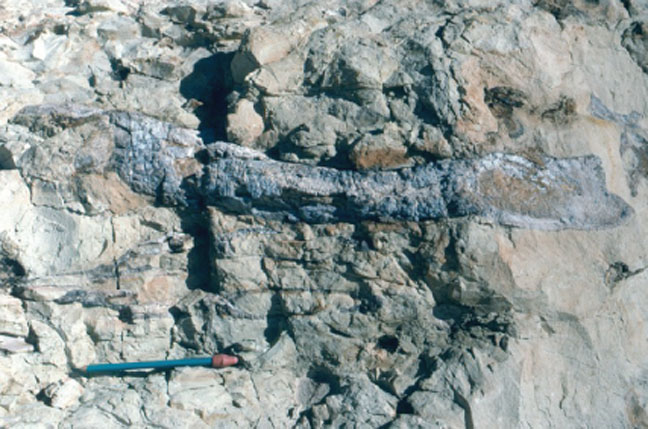|
|
How Long Ago?
Jan
01, 2009
When
presented with the Electric Universe
theory and the planetary
catastrophes that might have
occurred in the past, a commonly
evoked question is: When did it all
take place?There
are beds of coal covering millions
of square kilometers all over the
world. They vary in thickness and
composition, as well as in the
material combined with them in
situ. Insects, leaves, tree
trunks, rocks of every kind, and the
bones of animals from hundreds of
species abound—some say human bones
have been found in a Pennsylvania
coal seam. There are carbonized
trees standing upright in some coal
deposits, although how they extend
downward through so many "geological
ages" is a mystery to
paleontologists, since the layers
are said to progress through eons of
time: 250-500 million years ago.
There are forests of mineralized
trees under some of the deepest ice
in Antarctica. Cores drilled through
the ice sometimes contain scorched
and petrified wood fragments.
Mineralized trees cover large areas
of the American prairie, a so-called
"petrified forest" encompassing
thousands of specimens. Not
forgetting to mention the bones of
animals in unbelievable numbers
entombed within sedimentary deposits
hundreds of meters thick alongside
their fossilized forest home.
Fish skeletons in shoals that could
number in the millions of
individuals pose in frozen postures,
as if they are swimming through a
matrix of sandstone. What force
could bury a school of fish covering
thousands of square kilometers in an
instant, leaving their skeletons in
lifelike positions, fins extended,
mouths open, as if they were killed
and turned to stone in between one
breath and another? How could it
keep them whole, without being
disarticulated or crushed?
Trilobites, sauropods, pterosaurs,
cycads, ginkgos, clams, dragonflys—all
preserved for what is said to be
millions, hundreds of millions, and
even billions of years in a variety
of minerals. Some fossils, unlike
the fish that appear as if they are
still swimming, are broken and
disjointed, or scattered over a wide
area. Some are entangled in heaps
almost as tall as mountains, with
multitudes of different species all
mixed together in a grisly
zoological assemblage. Combined in
giant solidified piles with
splintered trees and shredded
leaves, one is hard-pressed to find
a singe intact skeleton amidst the
chaos.
When did the animals meet their
dooms? When did the forests burn,
freeze and then succumb to their
very tissues being replaced by
stone? How accurate is the system
used to date the fossil forests and
animal graveyards?
One of the most basic assumptions in
the development of an accurate
"calendar" by which events could be
dated was that the Earth is an
isolated celestial body that does
not interact with other bodies.
Another assumption is that
radioactive decay rates are
constant, Earth's energy cycle has
received no additional input since
the radioactive elements were
formed, or no alteration to its
electrical or magnetic fields have
taken place. That means geologists
can "rely on" a smooth, continuous
clock ticking off the millennia at a
measurable rate. Is that the case,
however? Is there evidence that the
radiometric dating methods that
scientists use with such confidence
can change?
Cosmic rays or electrical discharges
could increase the percentages of
C-14 ("radiocarbon") in living
organisms. If the remains of those
organisms were dated using the
standard radiocarbon ratios, they
would appear to be much younger than
they are, or much closer to the
present era than they should be.
Conversely, if an increase in
radioactively neutral carbon isotope
were to accumulate in our biosphere
from burning forests, from cosmic
dust, or from extensive volcanic
eruptions, anything dated following
whichever particular cause would
appear much older. No definite
timeline can be constructed using
the dating methods traditionally
thought to produce accurate results.
It seems possible that plasma
interactions with Earth and other
charged bodies in space, or the
impact of ion beams from a vast
cloud of plasma on our biosphere
could disrupt all the elemental
changes that are used to date rocks:
uranium changing to lead; potassium
changing to argon; or samarium
changing to neodymium. Therefore,
the Earth could be much younger than
the billions of years commonly
ascribed to it. It is equally
possible that it is much older than is
thought. Until some radical new
discovery is made, no one can be
sure.
By Stephen Smith
|
|
|
|
|
|
SPECIAL NOTE - **New Volumes Available:
We are pleased to announce a new
e-book series
THE UNIVERSE ELECTRIC. Available now, the first volume
of this series, titled Big Bang, summarizes the failure of modern cosmology
and offers a new electrical perspective on the cosmos. At
over 200 pages, and
designed for broadest public appeal, it combines spectacular
full-color graphics with lean and readily understandable
text.
**Then second and third volumes in the series are now available,
respectively titled Sun and Comet, they offer
the reader easy to understand explanations of how and why these bodies
exist within an Electric Universe.
High school and college students--and teachers in
numerous fields--will love these books. So will a large
audience of general readers.
Visitors to the Thunderbolts.info site have often
wondered whether they could fully appreciate the Electric
Universe without further formal education. The answer is
given by these exquisitely designed books. Readers from
virtually all backgrounds and education levels will find them
easy to comprehend, from start to finish.
For the Thunderbolts Project, this series is a milestone.
Please see for yourself by checking out the new
Thunderbolts Project website, our leading edge in
reaching new markets globally.
Please visit our
Forum
|
|
|
|
|
|
|
|







